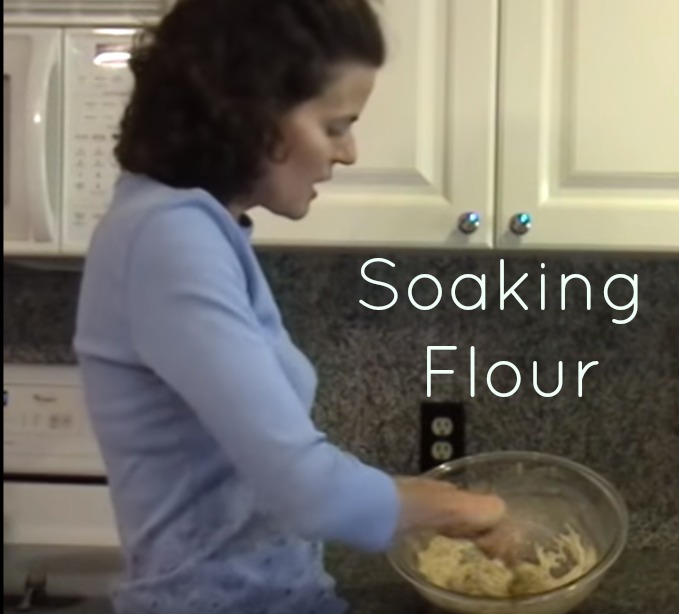Table of Contents[Hide][Show]
Soaking flour for maximum digestibility is one of the three traditional methods of grain preparation for healthy, nutritious bread as practiced by Ancestral cultures.
One of the most important baking techniques to learn when implementing a traditional diet is soaked flour. This ancestral method of grain preparation enhances digestibility and improves the metabolism of nutrients.
This technique also reduces anti-nutrients such as phytic acid in the grain flour. These substances block mineral absorption and can aggravate inflammation of the intestinal tract. Gluten-free grains also contain these anti-nutrients.
Other methods for reducing anti-nutrients in grains and improving metabolism include sour leavening (sourdough) and sprouting.
How to Soak Flour
Soaking flour is simple. Simply mix grain flour with yogurt, kefir, or clabbered milk, cover with a dishtowel, and let sit on the counter overnight. Freshly ground flour produces the best results. After the allotted soaking time, blend in the remaining ingredients and bake or cook as usual.
Non-grain based flours such as cassava and coconut flour do not need soaking. Others such as almond flour and chickpea flour are best soaked before grinding rather than after.
Dairy-Free
For those with milk allergies, substitute 1 cup of filtered water per cup of flour plus 2 TBL of lemon juice or apple cider vinegar and soak as usual for at least 8 hours or overnight.
For those with more extreme wheat sensitivities, the soaking time can be increased up to 24 hours to further breakdown gluten and other anti-nutrients.
Soaking any longer than 24 hours risks the development of mold.
Soaking Flour Technique Applies to All Grains
The principle of soaking can be applied to whole grains as well, such as your morning oatmeal. It was common to soak oats overnight before cooking back before WWII. This step was apparently even suggested on the Quaker oatmeal box!
It seems with the modern preference for speed in food preparation, this essential step has been lost. Hardly anyone under the age of 80 even remembers it anymore.
Try soaking your oatmeal the night before and see how much more filling it is after you cook and eat it the next morning.
Instead of being hungry again at 10 am, you will likely be full right through until lunch! To soak oatmeal, use 1 cup of warm filtered water per cup of oats plus 2 TBL whey, yogurt, kefir, or buttermilk. Stir together in the pot you will cook them in, cover with the lid, and leave overnight.
Cook, as usual, the next morning.
Bread Recipes Using Soaked Flour
Try this soaked bread recipe with your soaked flour. You can also try making a soaked loaf in a bread machine.
The video in the recipe tutorial below demonstrates visually the simple process of soaking flour. Try it with your next flour-based recipe!

How to Soak Flour
How to soak flour of all kinds before making the batter to improve digestibility and nutritional benefits of bread and other baked goods.
Ingredients
- 2 cups flour preferably freshly ground and organic
- 2 cups whole milk yogurt
Instructions
-
Mix flour and yogurt in a large bowl.
-
Cover with a clean dishcloth and secure with a large rubber band.
-
Leave on the counter overnight or for 8 hours.
-
Uncover, mix in remaining ingredients for whatever recipe you wish to make and bake as usual.
Recipe Video
Recipe Notes
Clabbered milk or plain kefir may be substituted for yogurt.
If there is a dairy allergy, 2 cups of water plus 2 Tbl lemon juice may be substituted. This reduces the calories to 910 for one batch.








Hi Sarah,
I have a recipe for buckwheat pancakes using 1 cup Buckwheat flour…Do I soak the flour in 2 cups of water over night with 2 tbspns lemon juice?
What about the 1 1/4 cups of rice milk I need to add to the recipe along with the baking soda, eggs etc? Do I add the rice milk after soaking, OR do I soak the buckwheat in the rice milk?
Thank you Sarah
Sarina
You will have to experiment a bit to determine how much liquid added after the soaking needs to be reduced. I can’t tell you exactly how to modify an unsoaked pancake recipe into a soaked one … it takes a bit of experimentation on a case by case basis. Here are my pancake recipes if that helps. https://www.thehealthyhomeeconomist.com/recipes/breakfast/pancakes/
Hi Sarah,
I just read above regarding soaking flours. When we soak grains, legumes or seeds, we soak to remove the acids and make them more digestable. We throw away the water and rinse well.
But with flour, we cannot rinse, aren’t we then essentially eating the acids/ the bi products the flour has removed that makes this digestable? Does this make sense?
We can’t rinse flour?
IN terms of ratios, if our recipe calls for 1/2 cup of flour, do we soak with 1 cup of water and 1 tspn lemon/acidic medium?
Thank you so much
Sarina
The phytic acid and other anti-nutrients are broken down into components that if eaten, won’t cause digestive distress or block mineral absorption. For example, after soaking oatmeal overnight, you don’t have to rinse it before cooking. Some people do, but you don’t have to.
How do I soak a batter that doesn’t call for 1:1 ratio of dry and liquids? My cassava flour ginger loaf requires 1 cup of flour(s) + only 1/4 cup melted coconut butter… The 2 eggs would help but you can’t add eggs before fermentation…
You don’t need to soak cassava flour. It is not a grain-based flour and is only starch.
Does buckwheat flour benefit from soaking? I know you soak the groats but what about store bought organic buckwheat FLOUR?
Store bought buckwheat flour is very bitter. You really should grind buckwheat fresh yourself. You do not need to soak buckwheat flour as it is much lower in anti-nutrients than grain based flours. Buckwheat is a pseudo-cereal grain … more of a seed. That said, if you digestion is very sensitive, you can soak buckwheat flour too for optimum digestibility.
Ok. If I were making bread instead of pancakes, I see how to soak the flour; but after the 8 hours or overnite, what next? would I eventually knead the dough? would it be ok to add light dusting of flour on board to knead a bit? & do I think about rising? Would I use a dry yeast in a packet for bread, even if I have soaked the flour? I’m just not quite ready to start sour dough bread, & making my own starter yet, but eventually I will.* so until then, I’d love to make bread & tortillas & pita bread.
Hi Sarah,
For my daughter I am using oat flour as I don’t want to expose her to wheat yet. To make cookies, would you do this same method? With oat or wheat flour?
Yes, the soaking would be the same.
I followed these instructions to my flour, but fpund the consistency was no longer appropriate for making a pie crust or crackers. What should I do?
Regarding sprouting, the 2 sources I know of that sell Einkorn berries (including Jovial) state that it may not sprout. How are you sprouting yours when you use sprouted flours (and not buying it, it’s very costly for regular use). Thank you for your help.
Soaked flour is not appropriate for a pie crust. If you are going to use it for another recipe, you will need to experiment a bit to adjust it for the additional moisture.
Thank you for your response. I usually just have white vinegar for cleaning but it is pretty bad with the glyphosate and GMOs. My acv is White House detox acv. Maybe it’s the detox I’ll switch to regular ACV. It is safe to assume white flour doesn’t need soaking since the bran is removed correct?
I don’t feel that white flour needs to be soaked as the bran which contains the anti-nutrients is already removed.
My ACV says to use within 3 days of opening so I always toss it and many times only have white vinegar can this be used when soaking grains in water instead of avc? Thank you for the video!
ACV lasts forever in the pantry. Not sure what brand you are buying that says use within three days! That said, yes you can use white vinegar but know that almost all white vinegar on the market comes from GMO corn and likely has glyphosate residue.
Could you please explain how to adapt a quick bread recipe?
Traditional bread recipes are not adaptable to modern quick bread recipes because they use slow, careful traditional methods, not fast modern methods that leave anti-nutrients in the bread which makes it very indigestible. Hope that makes sense! Here is a soaked bread recipe you can do in the bread machine, that is about as quick as you are going to get. https://www.thehealthyhomeeconomist.com/bread-machine-loaf-made-with-soaked-flour/